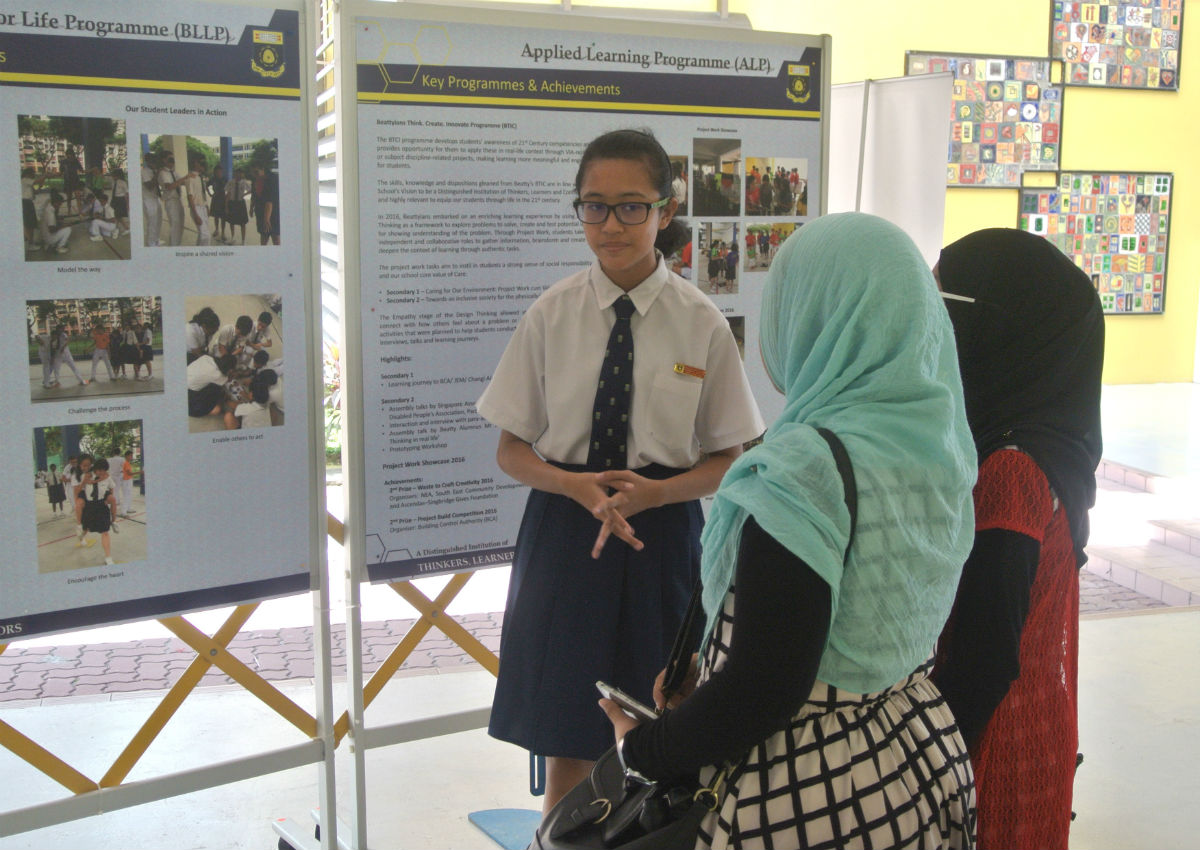When choosing a secondary school, Aasmiya Mohamed Tahriq, 12, is considering three key points: the school’s cut-off point, proximity to her home, and whether it offers her mother tongue.
She said: “My family and I (listed) several schools around my Primary School Leaving Examination (PSLE) marks and chose those near my home at Farrer Park. Schools not offering Tamil language as mother tongue are also excluded from our list.”
She attended Beatty Secondary School’s open house with her sister last Friday.
The school will open its doors to prospective students and parents until tomorrow .
It is known for its achievements in the performing arts and uniformed groups.
Its principal, Mrs Marion Tan, said: “(Through this open house) we want to highlight the school’s holistic education, which includes developing our students’ critical and inventive thinking, as well as their information literacy skill.
“Such skills are honed through community or subject-based project work, hence making learning more meaningful and engaging for students.”
Another visitor at the open house, customer service executive Chew Ching Huat, 51, explained how his family helped his daughter, Charlene Chew, 12, choose a secondary school.
Cut-off points
Knowing his daughter scored above 220 for PSLE, he zeroed in on schools where the cut-off point last year was between 210 and 230.
They visited several schools to gauge how helpful the teachers were and how the students behaved.
“After this, we’ll discuss which suits her most, which interests her, taking into account our own observation during the open house,” Mr Chew said.
Ms Elleen Goh, 44, was starting a year early, taking her daughter, who is in Primary 5, to the open houses at four schools.
Ms Goh said: “I think it’ll be helpful so she can see what the schools are like, know for herself what school she wants, and work hard for it.
“Her secondary school (options) depend on her marks and her own preference.
“She will be the one doing the homework and shouldering the burden of schooling. So I think it’s fair if she decides where to go.”
School’s cut-off point, IP programme are deciding factors
The school’s cut-off point and whether it offers the Integrated Programme (IP) are two deciding factors commonly cited by prospective secondary school students and parents interviewed by The New Paper at Cedar Girls’ Secondary School’s open house last Saturday.
It is a dual-track school, offering both the four-year O-level programme and the six-year Victoria-Cedar Alliance Integrated Programme (VCA IP), jointly offered with Victoria School and Victoria Junior College.
Started in 2012, the VCA IP allows students in the programme to proceed directly to Victoria Junior College after four years in Cedar Girls’ Secondary.
Mr Vijay Khasnavis, who was at the open house with his twin daughters and his wife, Mrs Bindu Khasnavis, said: “We considered schools whose cut-off points are within the range of my daughters’ PSLE score, and how well the cut-off point has (been) maintained throughout the past years.
“Also, my wife’s priority is to choose a school offering Hindi as a mother tongue, as we don’t want our children to attend extra mother tongue classes during the weekend.”
His fraternal twin daughters, Nikhitha and Nishitha, both 12, had scored above last year’s cut-off point for the school’s IP and O-level programmes.
Mr Khasnavis said: “There are many key things to consider, like whether to choose the IP or the O-level track, the demeanour of the students, the dedication of the teachers, proximity to home, and CCAs.
“Such open houses give us a good insight so that all of us as a family can make a prudent choice for a suitable secondary school.”
Another parent, Dr Sivanand Krishnan, 46, a senior scientist, considers the school’s proximity to their home the most important factor.
He said: “We are also considering the IP due to its holistic approach and the chance to defer major exam stress until the A levels.”
His daughter, Prina Sivanand, 12, scored well enough to qualify for a number of schools with IP programmes and was considering schools offering the IP such as Cedar Girls’ Secondary and Singapore Chinese Girls’ School.
When TNP asked who gets the last say, Dr Sivanand said: “Of course we discuss and take her feedback, but we have the final say as she may not have sufficient information.”
Ms Cindy Seow, 40, and her Primary 5 daughter were checking out several schools’ open house, such as Cedar Girls’ Secondary and Temasek Junior College’s IP, so that her daughter could have a target in mind after her PSLE next year.
The housewife said: “We are particularly looking for schools with (Direct School Admisison) programme through dance or choir as my daughter is into the performing arts.
“Schools offering IP would also be good as they can directly go to a junior college.”
The principal of Cedar Girls’ Secondary School, Ms Cheng Hwee Yeang, said that the biannual open house hopes to show the school’s culture, programmes, and facilities to prospective students.
Ms Cheng said: “The highlight of this year’s open house is our school’s niche Social Innovation Programme, where students are given opportunities to develop their innovative thinking to create breakthrough solutions to real-problems.”
Recently, a group of 20 Cedar Girls’ students filmed a short video documenting Dakota Crescent residents’ memories and feelings of the place, in partnership with Tung Ling Elder Care.

This article was first published on November 28, 2016.
Get The New Paper for more stories.







